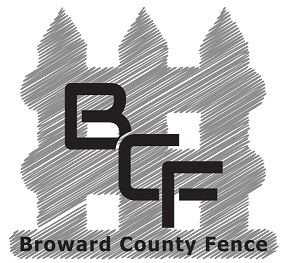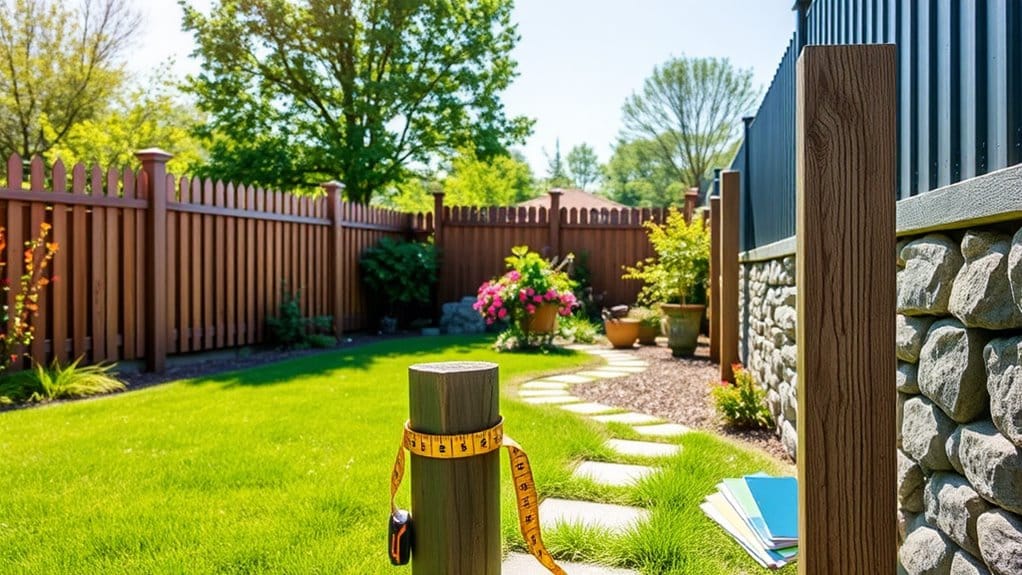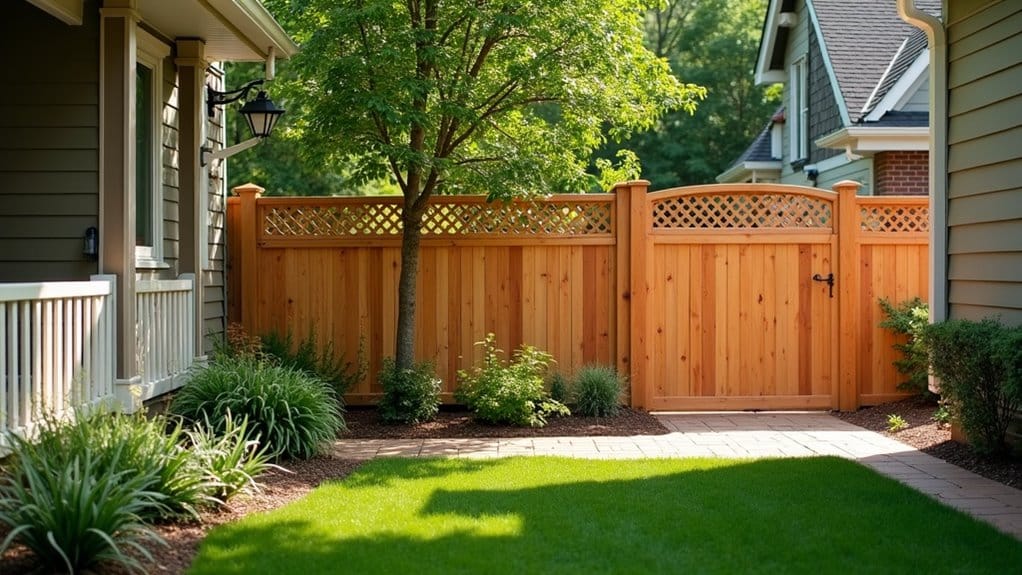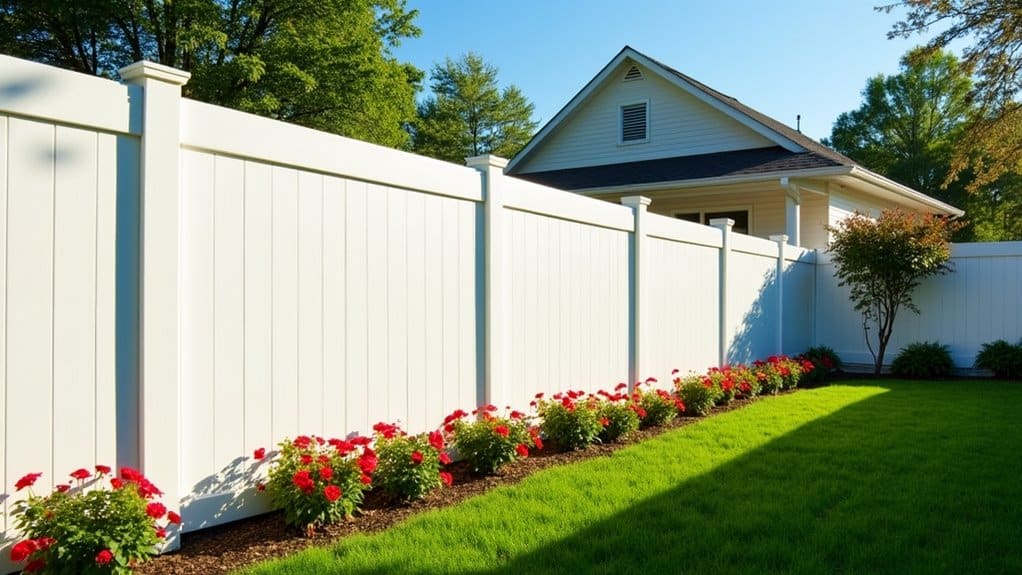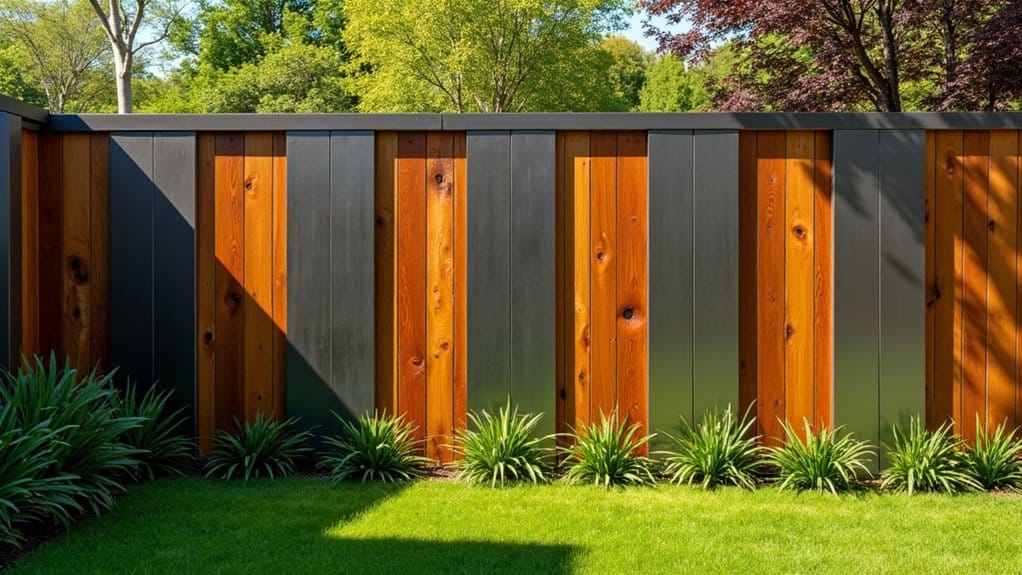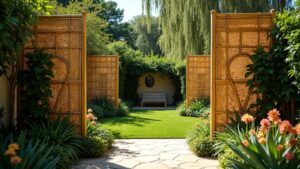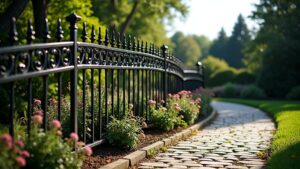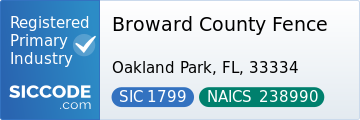Choosing the right fence for your home starts with understanding your needs and your yard. First, identify your property lines and decide if you want more privacy or security. Next, think about materials. Wood offers a classic look but needs regular maintenance, while vinyl is low-maintenance and durable, and metal can provide a modern aesthetic. Check local building codes and what your neighbors have to avoid any conflicts. Also, consider how your fence will work with your future landscaping plans. With these points in mind, you can find a fence that suits your style and needs.
Key Takeaways
- Evaluate your property's needs, like boundaries and landscaping, to determine the best fence fit.
- Clarify the fence's main purpose—whether it's for privacy, security, aesthetics, or keeping pets in—to shape your design choices.
- Select materials that match your needs for durability and upkeep, such as wood for warmth, vinyl for low maintenance, or metal for strength.
- Check local rules about fence height and permits to avoid any issues and ensure you follow neighborhood standards.
- Consider the maintenance and repair costs to keep your fence looking good and lasting long.
Assessing Your Property Needs
Choosing the right fence starts with understanding your property needs. First, clearly define your property boundaries to avoid disputes with neighbors.
Next, assess any landscape obstacles like trees or shrubs that could complicate installation. If your yard has a garden, think about how these features might affect your plans. Additionally, consider the existing landscape features that may influence the type and style of fence you choose.
Consider future landscaping as well—if you plan to add plants near the fence, ensure your design allows for that.
Also, check for drainage issues or public easements that might limit where you can place your fence; you might need gates or removable panels for maintenance.
Finally, be aware of local regulations on fence height and placement, as these can vary by municipality.
Identifying the Primary Purpose
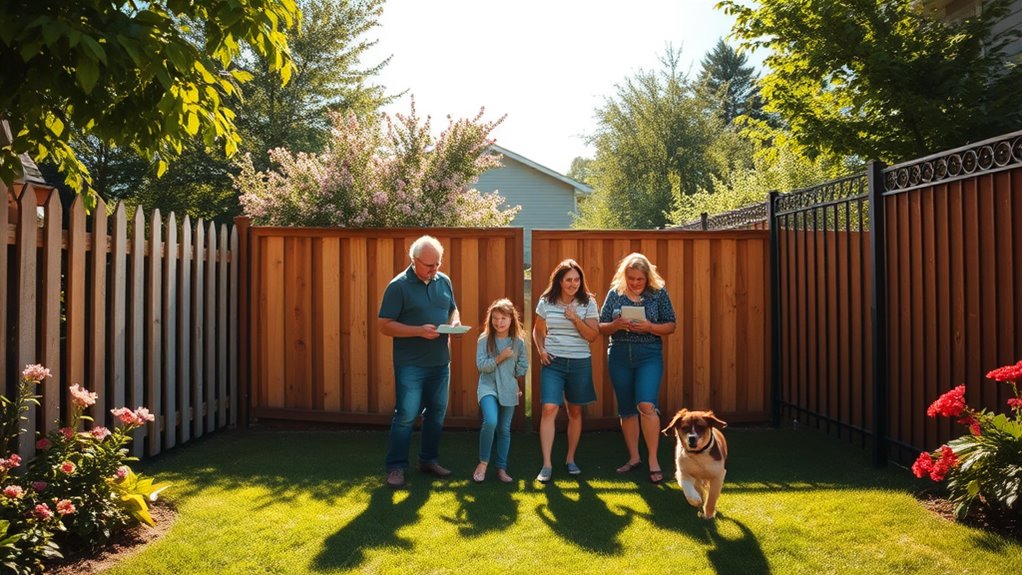
Identifying the primary purpose of your fence is crucial to ensure it meets your needs. Start by assessing your privacy concerns. If you want to block views from neighbors, choose a tall privacy fence made of solid materials like wood or vinyl. Solid materials are often recommended for their durability and effectiveness in providing privacy. Additionally, a tall privacy fence can also help with noise reduction, creating a more peaceful outdoor environment.
For security, consider strong options like wrought iron or chain link that deter intruders and mark your property boundaries.
Aesthetics matter too! A decorative fence, such as a picket or wrought iron design, can enhance your property's look and complement your landscaping. Make sure the style aligns with your home's architecture for a cohesive appearance.
Remember, a fence can serve multiple functions, like keeping pets safe or defining garden space. Think about the height and design based on how you plan to use it.
Evaluating Different Property Types
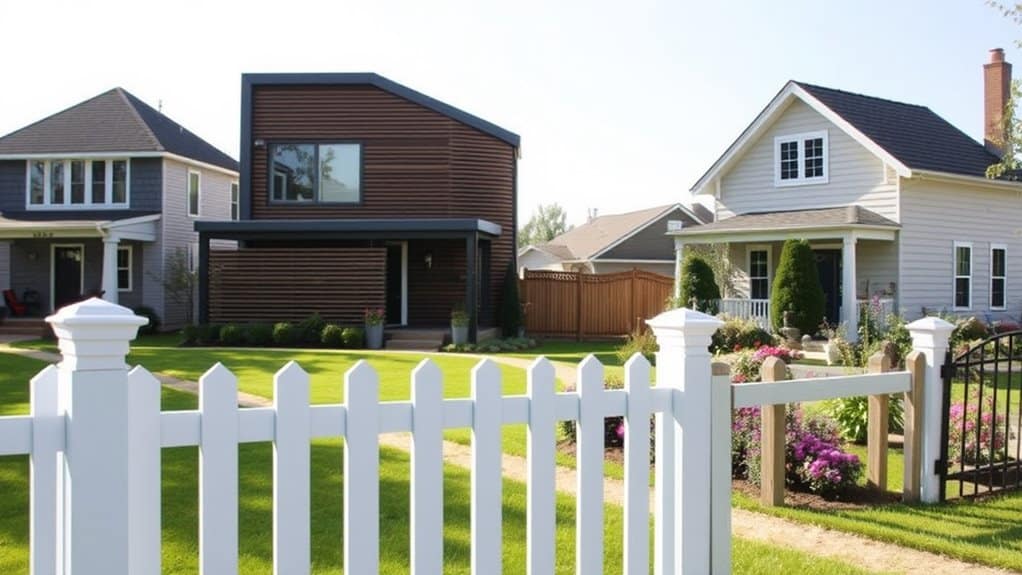
When evaluating property types, consider the differing needs of residential and commercial spaces. Urban areas often require stylish and secure fencing, while rural properties might prioritize durability for livestock protection. For privacy and security, selecting a taller fence can significantly enhance the safety of your property. Additionally, assessing local regulations can ensure that your fence complies with neighborhood standards.
Residential vs. Commercial Needs
When comparing the needs of residential and commercial properties, it's clear that each has distinct priorities. Residential properties typically prioritize aesthetics and safety, while commercial properties focus on security and functionality. Additionally, the choice of fencing material can greatly impact the overall look and durability of the fence.
Here's a brief comparison:
| Feature | Residential Needs | Commercial Needs |
|---|---|---|
| Purpose | Security, privacy, aesthetics | Security, asset protection |
| Material | Wood, vinyl, aluminum | Metal, chain link |
| Height | Lower for visual appeal | Taller for security |
| Design | Decorative styles | Functional and durable |
| Regulations | Local building codes | Business compliance |
For residential fencing, think about how it can enhance your home's look while providing safety. Additionally, many residential fencing options, such as aluminum fencing, are lightweight and durable, making them cost-effective and easy to install. In commercial settings, the focus should be on sturdy structures that ensure security and manage high traffic, with materials offering weather resistance to withstand harsh conditions. Recognizing these differences will help you choose the right fence for your property's needs.
Urban vs. Rural Settings
Choosing the right fence depends on whether you're in an urban or rural setting, as each has its own challenges and needs.
In urban areas, you must consider height restrictions and the neighborhood's look. Opt for materials like metal or vinyl that are both durable and visually appealing. For example, a sleek metal fence can provide security while blending into a modern landscape. Additionally, vinyl fencing is often cheaper than wood, making it a practical choice for urban homeowners looking to save on costs.
On the other hand, rural fencing is all about practicality. With larger properties and the presence of livestock or wildlife, sturdier materials like wood or barbed wire are often necessary. The fence design should fit the terrain, and gates need to be robust to handle strong winds.
Analyzing Your Landscape
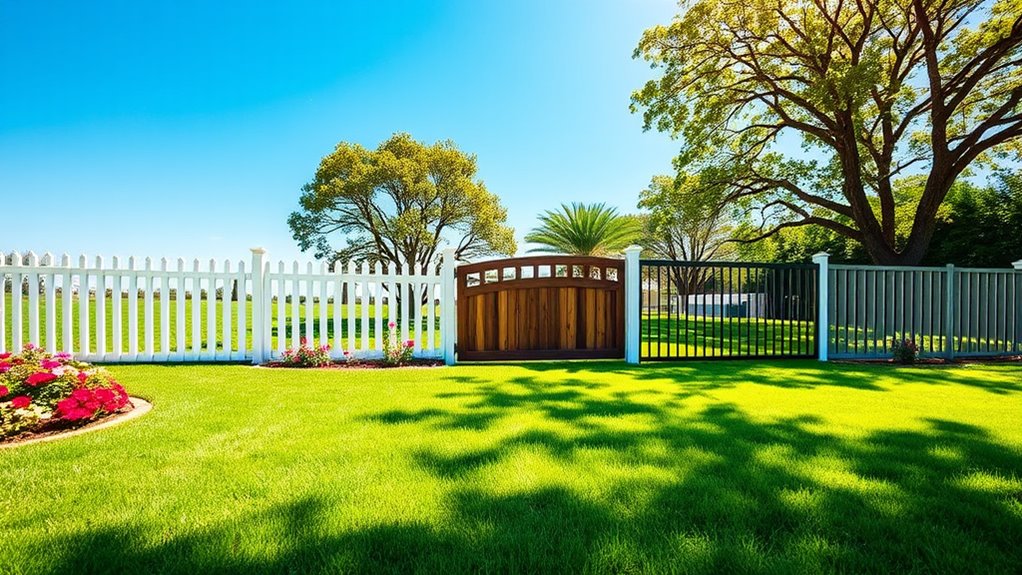
Choosing the right fence can greatly enhance your property, but it's essential to assess your landscape first.
Begin with a landscape evaluation to identify unique features. If your yard has slopes, a vertical fence is ideal as it adapts well to uneven ground, creating a cohesive look. This adaptability makes vertical fences particularly suitable for challenging landscapes.
Conversely, horizontal fences offer a modern aesthetic but require a level surface. You might need retaining walls for stability, complicating the installation process.
Consider how the fence design matches your home's style. A traditional house often looks best with vertical fences, while modern homes suit horizontal options.
Material choice is also crucial; select durable options that can withstand the weather and improve curb appeal.
Understanding Neighborhood Considerations
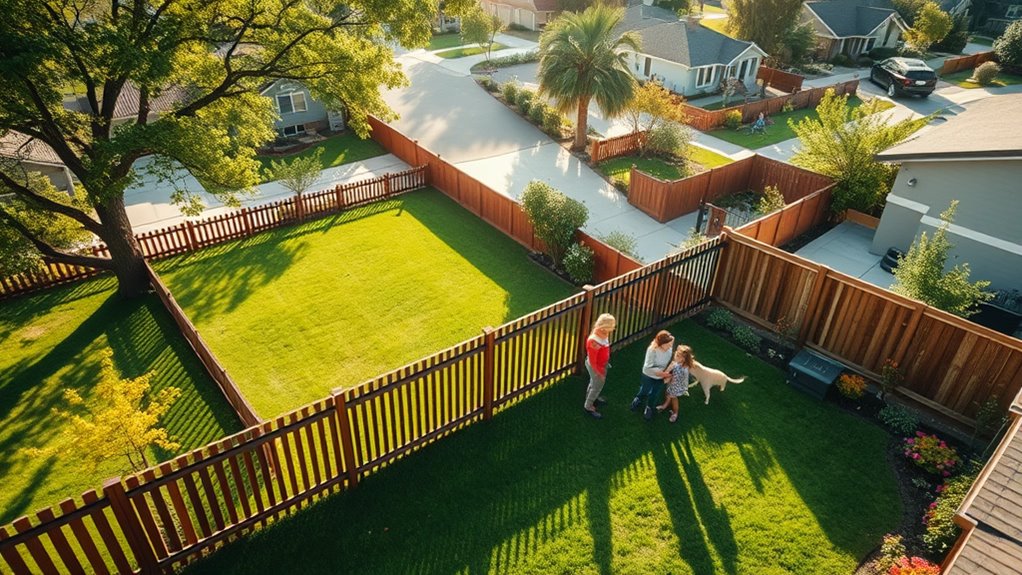
When choosing a fence for your property, it's important to consider your neighborhood. Keep local regulations and your neighbors' preferences in mind to create a harmonious environment.
- Be aware of zoning laws and HOA rules to avoid issues. Additionally, understanding permit requirements in your area can prevent future complications.
- Talk to your neighbors about your fence plans to maintain good relationships.
- Select fence styles that look good from both sides for mutual respect. Neighbor-friendly fences are designed to be attractive from both sides, promoting harmony in the community.
A fence is more than just a boundary; it reflects on your property and affects the community.
Choose materials and designs that complement nearby homes to enhance overall appeal. Think about how your fence will impact your neighbors' views and property values.
Always face the finished side of the fence towards your neighbor's property as a gesture of goodwill.
Setting a Budget
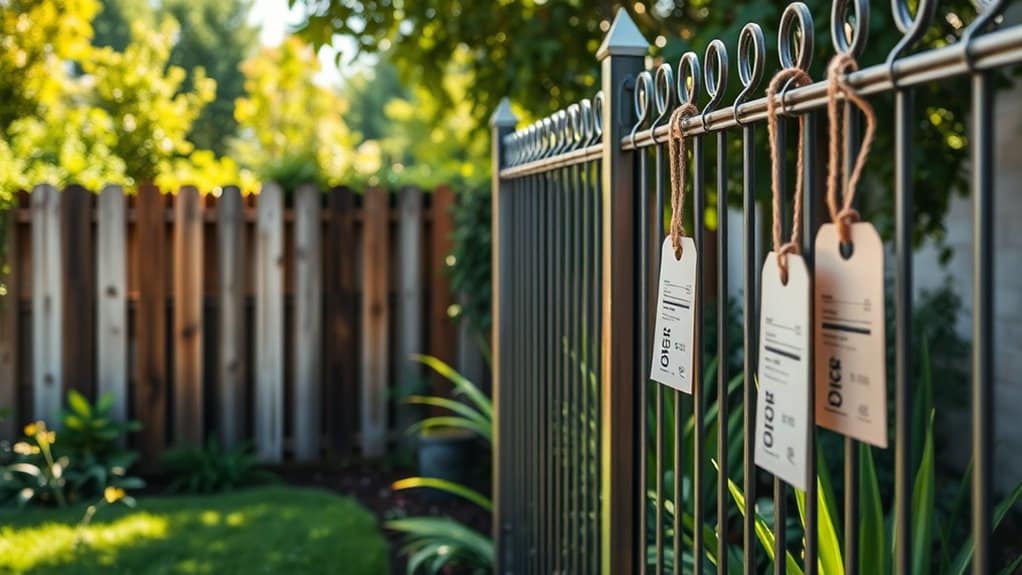
Setting a budget for your fence project is crucial to avoid overspending and ensure quality. Start by measuring your yard's perimeter and deciding on the type of fence you want. For example, wood fences typically cost between $12 to $27 per linear foot, while vinyl ranges from $15 to $30.
For a 200 linear foot fence, expect to spend anywhere from $4,000 to $10,000, depending on material choices and local labor. Additionally, keep in mind that total project costs for an average-sized wood fence can typically fall between $1,743 and $4,431. It's important to consider that labor costs can vary significantly, with some contractors charging up to $50 per hour.
Don't forget to factor in extra costs like permits, removing old fencing, and adjustments needed for sloped or uneven terrain. To keep your budget in check, create a simple spreadsheet to track material costs, labor, and additional expenses.
If your budget is tight, consider financing options, as many contractors offer payment plans.
Lastly, get quotes from several contractors to ensure you're getting a fair price. A little research can help you find a balance between quality and affordability, ensuring your new fence enhances your property without straining your finances.
Exploring Fencing Materials

When choosing a fencing material, each option has its pros and cons.
Wood provides a classic, natural look but requires regular maintenance.
Vinyl is a great low-maintenance choice with a modern vibe.
Metal options like wrought iron and aluminum offer strength and style, making them ideal for durability and security. Additionally, wrought iron offers a lifespan of over 50 years with proper care, making it a long-lasting investment for your property.
Wood Fencing Pros/Cons
Wood fencing is popular for its beauty and practicality. Its natural look enhances your property's curb appeal, making it more inviting. However, it's crucial to consider both its advantages and disadvantages.
Pros:
- Customizable: You can tailor it to fit your style and preferences.
- Cost-Effective: Generally more affordable than vinyl or metal options.
Cons:
- Maintenance: Requires regular upkeep to prevent issues like rot and insect damage.
- Durability: Lasts only 10-20 years, shorter than other materials.
- Environmental Impact: The production and treatment processes can have ecological consequences. Additionally, to ensure longevity, regular maintenance is essential to prevent major repairs.
While a wood fence offers privacy and security, it demands commitment and maintenance.
If you're ready to take on that responsibility, it can enhance your home and yard beautifully.
Understanding these pros and cons will help you make a better choice.
Vinyl Fence Advantages
A vinyl fence is a great option for homeowners looking for durability and style. One major advantage is its low maintenance; it's about five times stronger than wood and won't rot, rust, or stain from weather. Expect it to last 20 to 30 years, thanks to its weather-resistant features, including UV protection that prevents yellowing.
In terms of appearance, vinyl fences come in various styles and colors, some even resembling wood or stone, so you can customize your property's look. The one-piece panels offer complete privacy, and installation is quick and hassle-free.
Vinyl is also eco-friendly—it's recyclable and doesn't need harmful chemicals for maintenance. Cleaning it's easy, so it stays looking good without much effort.
With long warranties available, a vinyl fence not only boosts your home's curb appeal but also provides lasting value and peace of mind.
Metal Fencing Options
Choosing the right metal fencing can boost your property's security and curb appeal. Here are some popular options:
- Steel Fencing: This is a strong, durable choice that can last 20 to 30 years with proper care. While it provides excellent security, it offers limited privacy due to wider gaps between panels.
- Aluminum Fencing: Lightweight and rust-resistant, aluminum fencing is low-maintenance and versatile, allowing for various styles. It's generally less durable than steel but still provides good security and a polished look.
- Wrought Iron Fencing: Known for its classic elegance and strength, wrought iron offers great security. However, it requires regular upkeep, like repainting to prevent rust, and is heavier, often needing professional installation.
When selecting your metal fence, think about maintenance, style, and security.
Whether you choose the strength of steel, the convenience of aluminum, or the timeless look of wrought iron, each option can enhance your property's safety and appearance.
Choosing the Right Fence Style
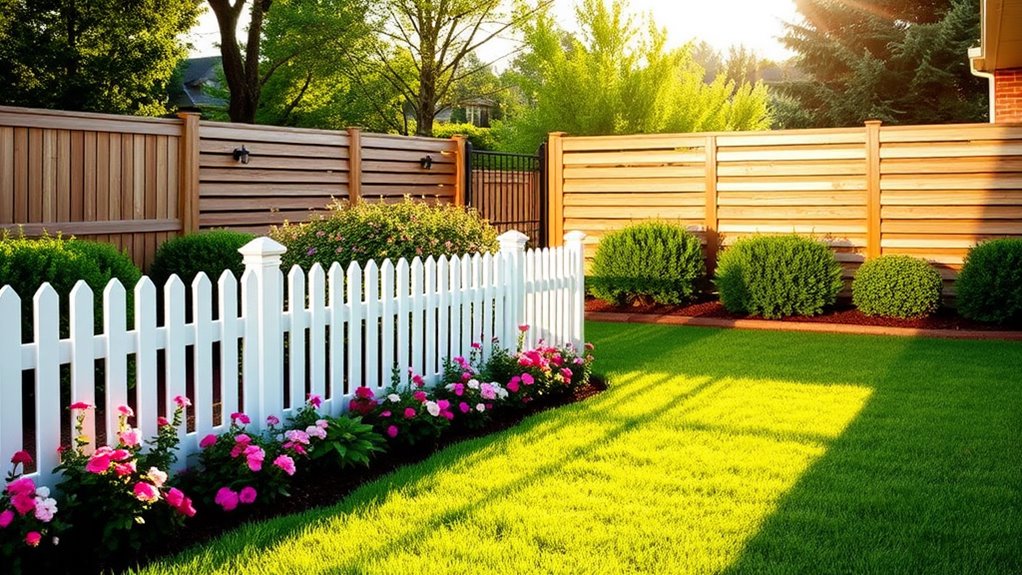
Choosing the right fence style is crucial for enhancing your property's functionality and appearance.
Consider various fence options that fit your needs and complement your home's design. For example, wood fences provide a natural look and flexibility in design, while vinyl fences are low-maintenance and durable.
If you prefer a modern touch, horizontal privacy fences could be the way to go.
Aesthetics matter; your fence should blend well with your home's overall style.
Ornamental metal fences offer both style and security, and ranch rail fences can enhance your landscape affordably.
For a touch of elegance with some privacy, lattice fences are an excellent choice.
Considering Fence Functionality
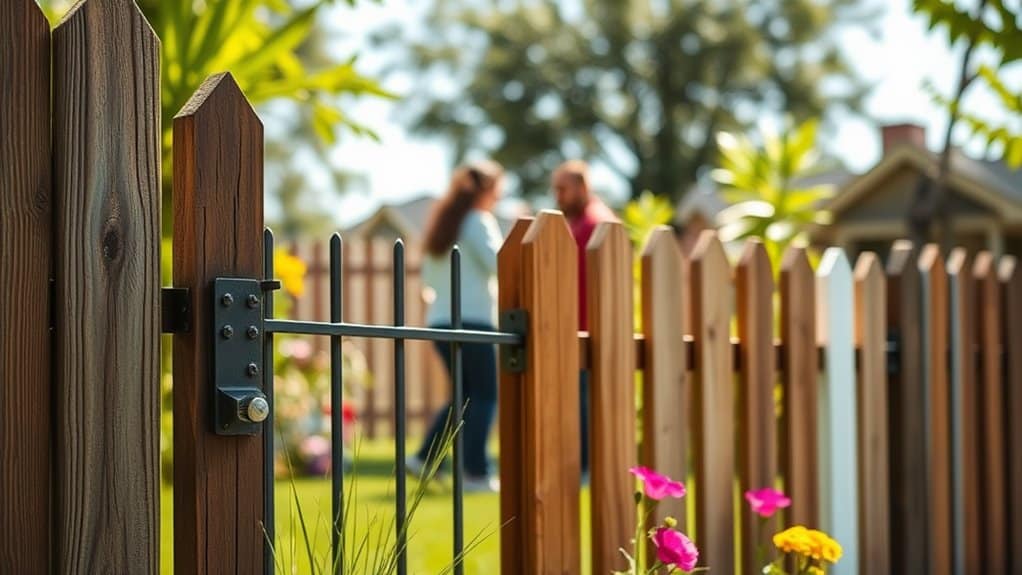
When choosing a fence for your property, it's important to consider its functionality based on your needs. Here are key factors to help you decide:
- Security vs. Aesthetics: If safety is your main concern, go for sturdy materials like wrought iron. For a more attractive option, ornamental aluminum works well.
- Privacy and Visibility: For total privacy, pick tall, solid fences. If you want some openness, look for designs that offer a balance of both.
- Child and Pet Safety: To keep kids and pets safe, choose strong fences like chain-link or picket styles that are also visually appealing.
Installation Factors to Consider
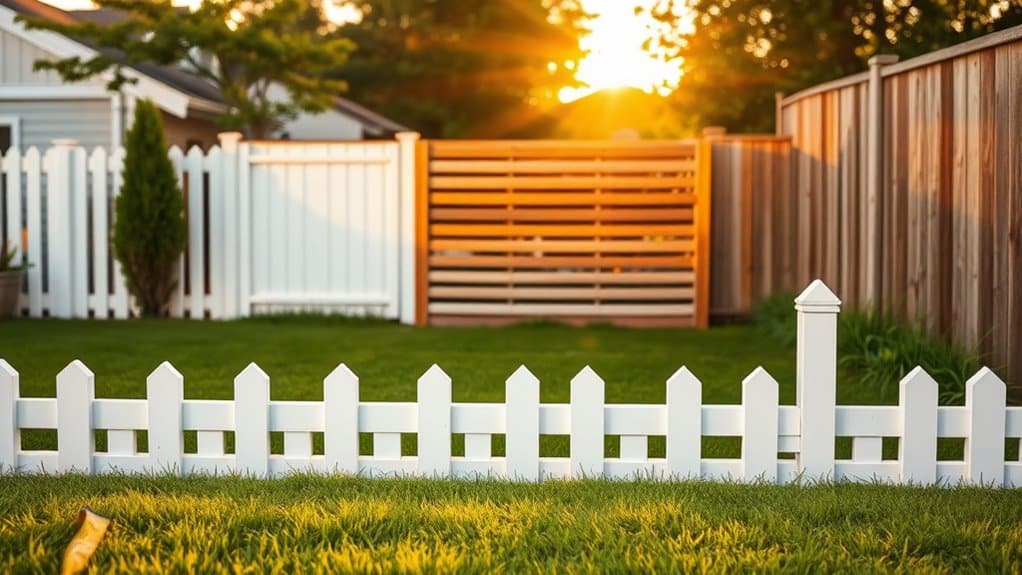
When planning your fence installation, consider its height for privacy and aesthetics, while also following local regulations.
Assess your site location; nearby buildings, trees, and the land's slope can affect your fence's appearance and function.
Lastly, check the soil conditions to ensure a solid foundation, which will help your fence last longer against weather and time.
Fence Height Considerations
When choosing a fence height, it's essential to consider local rules, your needs, and your home's style.
Here are some key factors:
- Privacy: If you want seclusion, a fence height of 6-8 ft is ideal, especially in crowded areas.
- Property Lines: A 4-6 ft fence is usually enough to define boundaries without overpowering your yard.
- Neighborhood Harmony: Sticking to the height of nearby fences helps maintain a unified look in your community.
Site Location Analysis
Choosing the right fence height is just the start; installation matters too. First, verify your property lines to ensure your fence is within legal boundaries and avoid disputes.
Check local regulations for rules on fence placement, height, and materials. A professional surveyor can clarify any uncertainties related to zoning laws and homeowners association guidelines.
Next, think about where to place your fence. Consider how it will blend with your landscaping and your neighbors' fences.
Make sure gates are positioned on flat ground for easy access and not in corners where they can be difficult to use.
Finally, consider your local weather conditions. If you live in a windy area, taller fences may need deeper foundations to withstand the elements.
Soil Condition Assessment
Assessing soil condition is vital for a stable and durable fence installation. Here are key factors to consider:
- Soil Layers: Dig down at least 18 inches to check for textures and any hard layers like clay or bedrock beneath.
- Drainage: Ensure the soil is well-drained. Avoid areas with mottled patterns, which indicate poor drainage.
- Vegetation: Healthy, lush plants generally mean good soil quality.
Pay attention to rocks and debris; if more than 50% of your soil is made up of these materials, you may need to make significant adjustments.
Soil fertility tests can also help you determine pH and nutrient levels, guiding you in choosing the right fence materials and designs.
Importance of Fence Height

Understanding fence height is crucial for enhancing your property. The height you choose affects both aesthetics and security. Fences serve multiple purposes, such as decoration, privacy, and protection.
Here's a quick overview of common fence heights and their uses:
| Fence Type | Recommended Height |
|---|---|
| Decorative Fences | 3-4 feet |
| Privacy Fences | 6 feet |
| Security Fences | 8 feet or more |
The right height can transform your space. For example, decorative fences are shorter, offering an open view, while 6-foot privacy fences provide seclusion. If you have pets or children, consider a height that prevents them from escaping. Additionally, pool safety regulations suggest a minimum height of 4 feet.
Ultimately, it's about finding a balance between looks and security. Taller fences deter intruders and clearly define your property, enhancing both appeal and safety.
Local Regulations and Guidelines
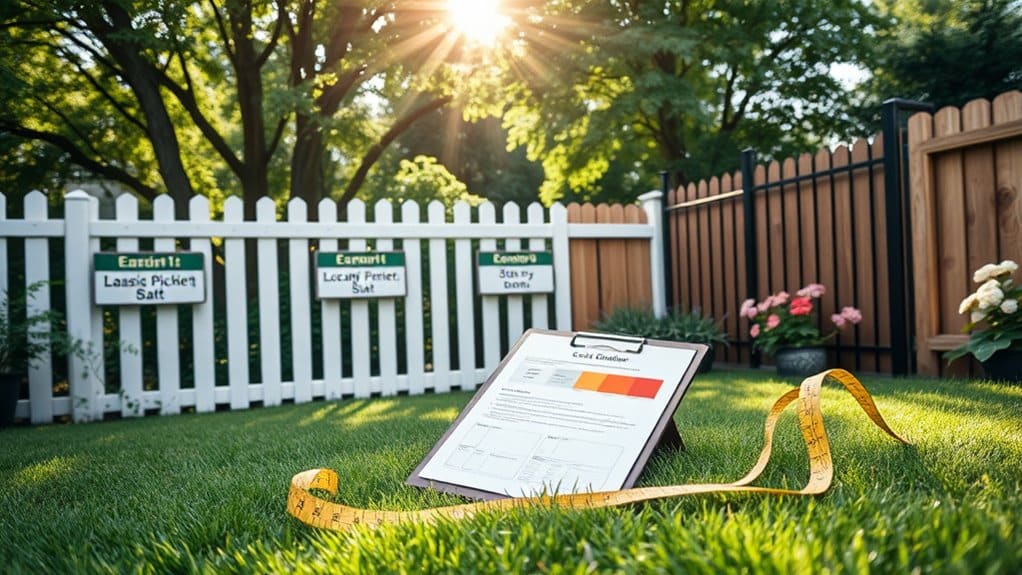
Understanding fence height is just the start; local regulations are crucial for your property decisions. Here's what you need to know:
- Height Limits: Front yard fences usually can't exceed four feet unless they're set back properly.
- Visibility: Ensure your fence doesn't block views for drivers or pedestrians, particularly at intersections.
- Materials and Design: The materials you choose can impact both appearance and permit requirements.
Before putting up a fence, check with your local zoning department to avoid issues. While standard fences typically don't need permits, those that are taller or in specific zones might.
Also, if you belong to a homeowners' association, be aware they may have their own rules on aesthetics.
Following these guidelines not only keeps you compliant but also improves your property's look.
Take the time to research and plan to create a fence that suits your needs while meeting local standards.
Maintenance and Care Requirements
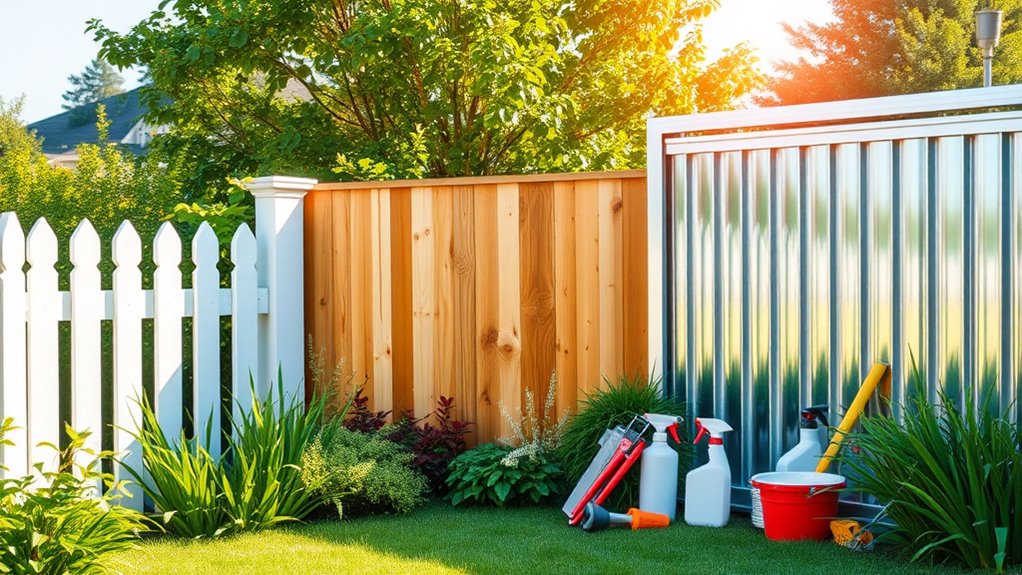
Caring for your fence is crucial for its appearance, longevity, and safety. Different materials require different maintenance.
For wooden fences, regular cleaning with mild detergent and a soft brush is necessary to prevent mildew. Cedar fences need seasonal inspections and sealants for moisture and UV protection.
Vinyl fences are nearly maintenance-free—just clean with soap and water occasionally. Chain link fences should be checked for loose wires and rust. Metal fences may require repainting or rust prevention treatments to stay durable.
Schedule maintenance tasks by season: clean and inspect in spring, check for sun damage in summer, clear leaves and apply sealant in fall, and look for winter damage in winter.
Keeping up with these tasks not only improves your fence's look but also extends its life and ensures safety. Make it a routine, and your fence will last for years.
Evaluating Durability and Longevity
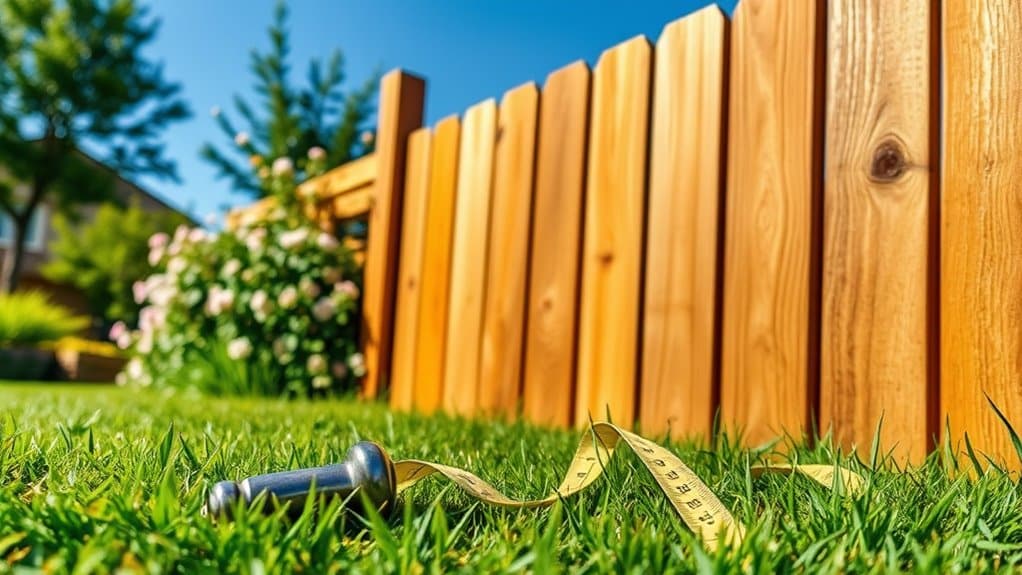
When choosing a fence, it's important to know how long different materials last.
Think about how weather conditions and maintenance will affect your fence's durability and overall lifespan.
For example, a vinyl fence may require less upkeep than wood, which needs regular painting or sealing.
Material Lifespan Comparison
When choosing a fence, durability is key as it affects both performance and lifespan. Here's a quick comparison of popular materials:
- Vinyl Fences: Last over 30 years with little maintenance, perfect for busy homeowners.
- Redwood Fences: Can last up to 25 years due to their natural resistance to rot and insects.
- Cedar Fences: Typically last 15-20 years but need regular upkeep to extend their life.
Consider the environmental impact of your choice. Composite fences, made from recycled materials, are durable and reduce waste.
While wood options like cedar and redwood are attractive, they require more maintenance. In contrast, vinyl and composite materials outlast traditional wood and require less attention over time.
Weighing longevity against environmental factors can help you pick the best fence for your property. Choose wisely for a lasting investment.
Weather Resistance Factors
When selecting a fence, consider how different materials will perform against your local weather. In areas with extreme heat, vinyl or composite fences are ideal as they resist fading and warping.
For humid climates, aluminum and vinyl are moisture-resistant, preventing rot and maintaining color.
If you face strong winds, metal options like aluminum or galvanized steel provide strength and flexibility to withstand gusts.
In snowy regions, composite fences handle moisture and weight well.
Assess environmental factors that affect your fence's longevity. Proper spacing and depth in design can enhance stability.
Choosing the right material not only protects your investment but also boosts your property's appearance. A focus on weather resistance ensures your fence looks great and lasts for years.
Maintenance Impact on Longevity
Maintaining your fence is essential for its longevity and appearance. Here are some straightforward strategies to boost its lifespan:
- Clean your fence regularly with a mild detergent suitable for its material.
- For wood fences, apply protective coatings to fend off moisture and pests.
- Fix any damage right away to keep it structurally sound.
With proper care, wood fences can last 10-20 years, while vinyl and metal options may last 20-30 years.
Be mindful of environmental factors like humidity and UV exposure that can shorten lifespan. Regularly inspect your fence to spot issues early and avoid expensive repairs.
For metal fences, use rust-resistant paint and watch for insect infestations in wood fences.
Repair and Replacement Considerations
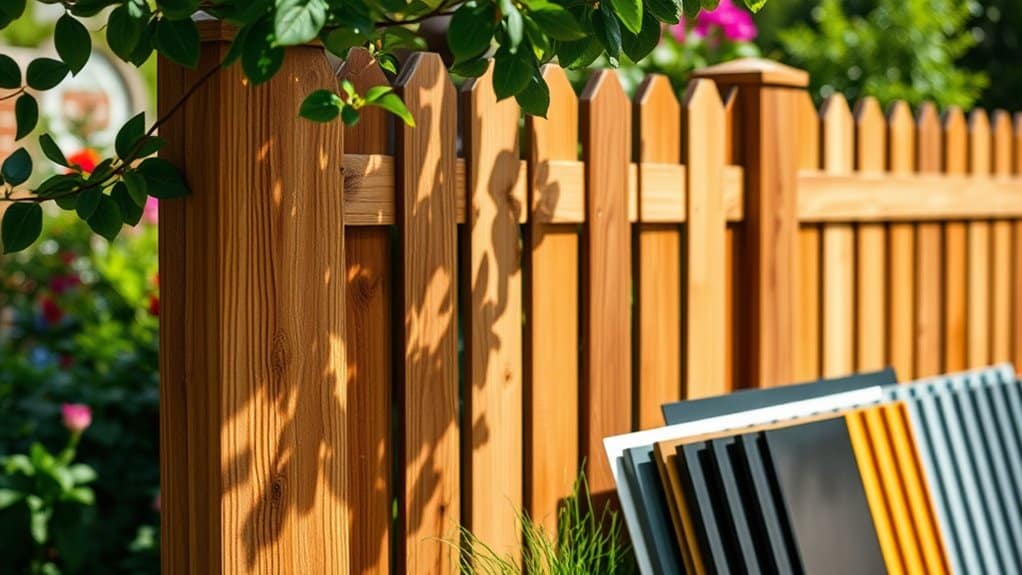
Over time, fences can wear down, so it's important to check their condition regularly. Look for damage like wood rot, rust on metal, or cracks in vinyl. Leaning posts may signal soil erosion or instability.
For repairs, stabilize rotted posts with metal menders or concrete, and replace broken wooden boards with new ones, using screws for secure attachment. If your gate is sagging, tighten the hinges or use an anti-sag cable kit.
When deciding to replace your fence, consider the extent of damage. If it's severely decayed or structurally unstable, replacement is the better option.
Also, think about the age of your fence; if it's nearing the end of its lifespan, replacement could save you money in the long run. Additionally, replacing rusted fasteners and fittings can help extend your fence's life.
Following these guidelines will keep your fence strong and effective as a property boundary.
Frequently Asked Questions
What Are the Best Colors for Fence Materials?
When selecting fence colors, think about their psychological impact and current trends. Classic colors like black and white offer a timeless elegance, while earthy tones add warmth. Bold colors can bring energy to your space and showcase your personal style.
Can I Install a Fence Myself or Hire a Professional?
You can choose to install the fence yourself, taking on the challenge as a DIY project, or hire professionals to do the job for you. If you're handy and enjoy projects, a DIY installation can be rewarding. On the other hand, hiring experts can save time and ensure the job is done right. Either option can make your fence dreams a reality—just decide which approach suits you best!
How Do I Choose Between a Gate or a Door?
When deciding between a gate or a door, think about the materials—wood for a classic look or metal for strength. Consider how each option fits with your home's style. For example, a wooden gate can add charm to a garden, while a sleek metal door might enhance a modern entryway. Balance function with aesthetics to boost security and curb appeal.
What Is the Typical Lifespan of Different Fence Types?
When it comes to fence lifespan, wood types vary significantly. Cedar lasts about 15-30 years, while redwood can go beyond 25 years. On the other hand, vinyl fences are a strong choice, lasting 35-40 years with minimal maintenance, making them a great long-term investment.
Are There Eco-Friendly Fencing Options Available?
Yes, there are eco-friendly fencing options available. Bamboo is a great choice due to its strength and rapid growth. Fences made from recycled materials are also sustainable, helping reduce waste while adding visual appeal to your property.
Conclusion
Choosing the right fence for your home is essential for both security and aesthetics. Start by assessing your needs, such as privacy, safety, or noise reduction. Check local regulations to ensure compliance. Consider maintenance requirements and materials that suit your climate. A good fence not only enhances your property's appearance but also adds value. Ultimately, a well-selected fence is a smart investment that provides peace of mind for years to come.
